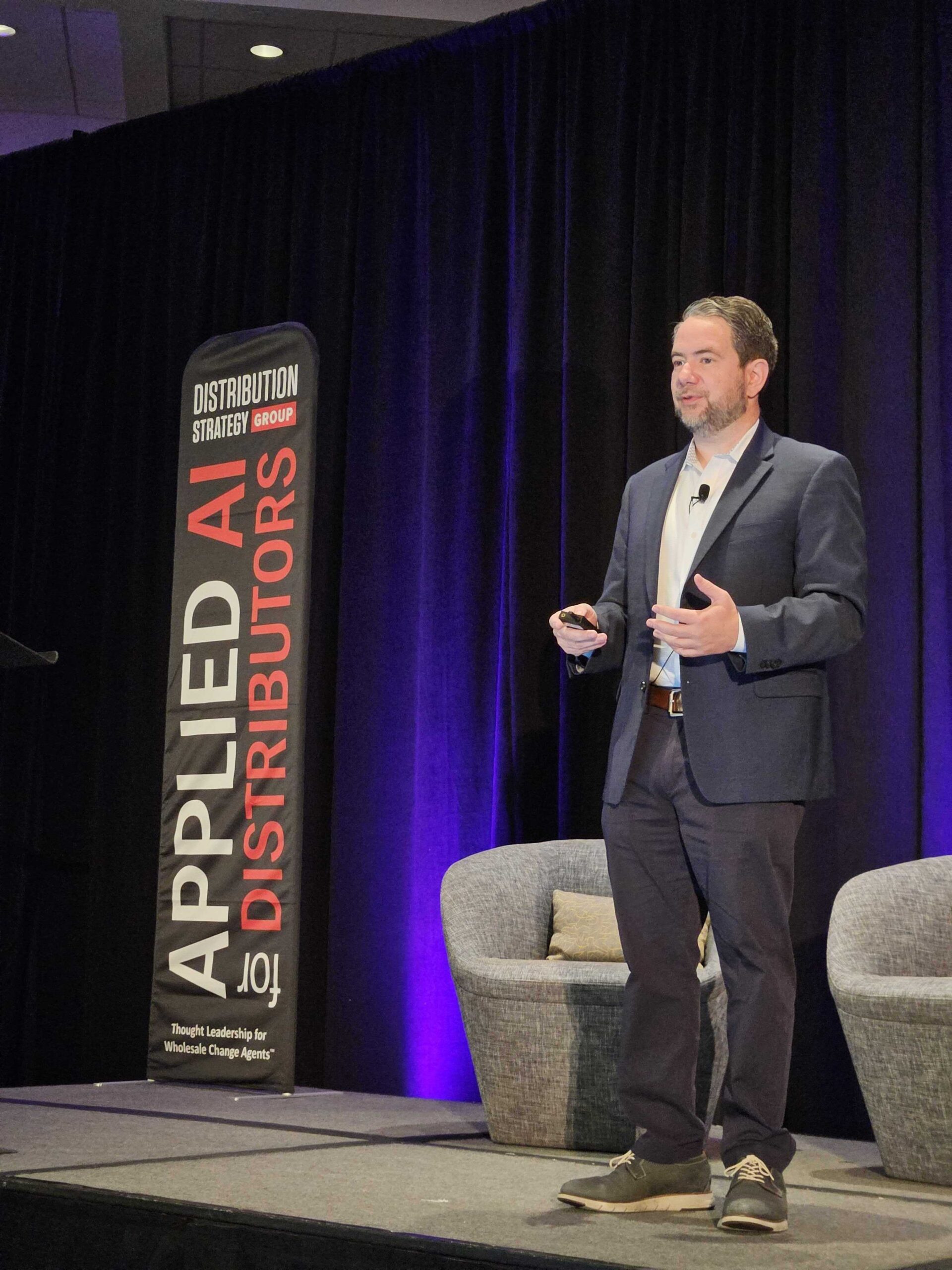As we noted yesterday, distributors at our Applied AI for Distributors event in Chicago this week were all ready to move forward with AI. But while some had dipped their toes in the water, these early adopters were still looking for guidance on their long-term play.
Our final day of the event provided direction, with a strong focus on building a strategy and a playbook for AI.
Here are some takeaways from the final day of our inaugural event focused on AI for distributors.
“AI is too big for just one person.”
Klaus Werner, a technology expert with executive experience at Global Industrial, said the first thing distributors need to do is cast a wide net.
AI is far too big to limit to one person or part of your business. If distributors want to get the most from the technology, they need to treat it like the transformational technology it is. He likened AI’s impact to that of the computer, browsers, smartphones and companies like Uber that changed how we live and work.
Use Cases for AI
With that in mind, Werner outlined 10 use cases for AI spanning multiple functional areas:
- Customer service voice: This will improve significantly over time.
- Supply chain optimization: This includes demand forecasting, vendor analysis and more.
- eCommerce: “We’re just at the tip of the iceberg with personalization (online),” Werner said.
- CRM: AI can make sales reps far more productive. “We make our sales reps work too hard,” he said.
- Operational efficiency: Distributors can find new and improved ways of improving productivity, and reducing waste, effort and material use.
- Content creation: Low-hanging fruit includes scaling product content creation.
- Recruiting: Distributors will be able to better source and screen candidates, and one day predict which candidates are most likely to be successful.
- Financial planning and analysis: Distributors need to be able to do more with less in the back office.
- Online chat: While chatbots don’t have the greatest reputation now, Werner said, the potential is huge for AI to transform that.
- IT security: AI will unleash more ways to protect your IT infrastructure and data, but bad actors have access to the same technology. It will become a cat-and-mouse game, Werner said, so IT leaders need to get ahead now.

What First?
Werner said distributors need to keep this core principle in mind when developing their AI strategy:
- Keep the customer at the center of every decision you make. This isn’t about just adopting technology; it’s about making the customer’s experience better.
Brooks Hamilton, another AI expert, went into the specifics around building an AI roadmap. His advice? Human to human is still crucial, so don’t lose the personal touch. “Understand where humans act like machines (in their work). That’s where the opportunities lie to automate.”
In other words, AI should let humans be more human, automating the work that machines can do better. (This was a common mantra during the conference.)
Getting Started
Hamilton mapped three phases of the AI journey. The first is where most distributors fall today. It includes:
Embrace: Face it: Generative AI is probably already in use in your four walls, Hamilton said. Seek out where. Sales and marketing team members likely have leveraged ChatGPT for content support, for example. Rather than shut that down, engage them. Learn how they are using it, and where it’s already helping them do their jobs better. Find those champions of AI to help lead your company’s efforts.
Educate: Start Best Practices Learning Groups to encourage your team to learn from each other, as well as document what’s working, and what’s not to get the most out of these tools. Start to create a policy: What tools can they use? How can you protect privacy and ensure security? When shouldn’t they use it? Educate your leadership team, as well. Make room in your 2024 budget to expand education, research, innovation and experimentation with AI.
Expand: Start to formalize usage, including training around key tools and setting expectations and rules around their use.
Moving into Phases 2 and 3, which we will outline in more detail in future articles, distributors will create more formal roles and processes, including working closely with functional teams to review processes and opportunities for improvement. This is when distributors will build organizational capacity for AI. It’s also when they should communicate more frequently with suppliers, customers and partners around how they are using AI because they will get those questions, Hamilton said.
Through it all, Werner advised, bring IT security along for the ride. They may slow things down, but they will protect you.
Werner also echoed what many of our experts shared on the first day of the conference: that you need to crawl before you walk, and walk before you run. And don’t be afraid to fail.
Prioritize Change Management
One of the primary reasons AI projects fail is because of poor change management; it isn’t usually because of the technical requirements, Hamilton said. He recommended tapping a change management leader to be a part of the team evaluating and implementing AI solutions. But if you don’t have or hire a change management pro, make sure your existing managers get formal change management training.
Thank you to all the distributors, sponsors and supporters of the first conference dedicated to AI in the distribution industry!
Did you miss our first recap? Check it out here: 5 Takeaways from Applied AI for Distributors: The Wave of Change Rushing Toward Distribution


